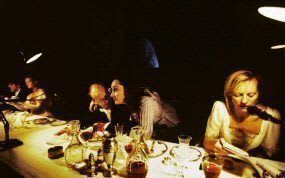Waves is the second novel adaptation to open at the National Theatre in a week. On the face of it, Virginia Woolf's classic, turned into a stage version with the definite article lopped off, could hardly be more different from Emile Zola's Thérèse Raquin.
However, as female directors Katie Mitchell with the English and Marianne Elliott with the French stories demonstrate, there are surprising opportunities for parallels between the experimentation of the stream-of-consciousness Modernist, Virginia Woolf and the grim realism of Zola. These primarily show themselves up in the depression that unrequited or illicit love can cause and the opportunities that the written word offers for visual fantasy.
In her last production at the National, Katie Mitchell split opinions adapting Strindberg's A Dream Play arguably to the point where the Swede's work disappeared without trace.
Some might say the same about Waves, with an extreme adaptation that veers between a film school and a radio studio. However, the result is absolutely intoxicating and is a compliment to the strength of vision of Miss Mitchell and the ensemble cast that helped her to devise this most unusual piece.
The plot feels like a combined autobiography of a number of Miss Woolf's friends from the Bloomsbury set, starting at the end of the Nineteenth Century. It takes them from the childhood nursery through school and university and eventually to middle-age. That is not quite accurate since Percival, a man of great beauty upon whom all of them dote, made it past the Great War and the subsequent flu epidemic but only by a few years.
Even from childhood, it is the worship of Percival that proves a common interest and force for so many of these characters and in particular, shy Neville for whom the homosexual attraction is overwhelming.
Otherwise, these characters lead well-to-do but generally unhappy lives, delineated in great detail by Virginia Woolf who also appears as the narrator, cigarette in hand on every occasion. Although there is a character named Ginny, one feels that it is the ultra-depressed Rhoda who might be more closely modelled on the writer.
The real attraction of this two-and-a-half-hour event is not in the plotting. As visitors arrive, they see a number of black-clad figures wandering around what looks like a workshop but becomes a radio studio. It is also more, since it presents surprising opportunities for the filming of images generally in stark close-up.
The director is happy to deconstruct her work so that we constantly see the cast acting very capably as Foley artists making sound effects for each other. Rather than playing single roles, the actors read the lines while their fellows are physically acting the part. For this reason, the programme does not credit any actor with a single part and since, at least vocally, they swap over with great regularity, that is only fair.
Even more entrancing than the audible is the visual. Not only do we watch what would normally remain behind the scenes bu,t in addition, with the assistance of designer Vicki Mortimer and her lighting colleague Paule Constable, visions are created, often of great beauty. These are projected on to a large screen behind the actors and have a kind of Proustian potency so that lives are conjured up by a few drops of red liquid or a Hornby steam engine.
It sounds as if this should pall after a few minutes but thanks to the great efforts of all concerned, it remains intense and mesmerising and by the end such is the interest generated in this elusive novel, bookshop sales must be immense.
